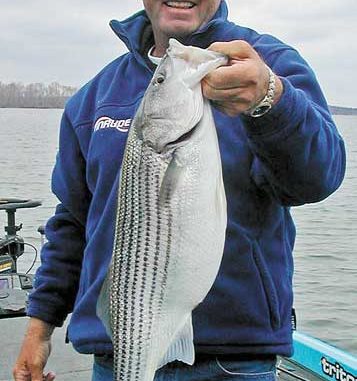
I guess you could say that for me to go fishing when I have time off, away from bass tournaments, is like taking a busman’s holiday. But fishing for fun is entirely different than competitive fishing, and I cherish the opportunity to get out on a lake and fish just for enjoyment’s sake.
That said, December is one of my favorite times to go fun-fishing, because setting out to catch stripers is my idea of fun. Although I love to fish for largemouth, smallmouth and spotted bass, I can’t wait for December to start fun-fishing for stripers, and just about all of our lakes — Clarks Hill, Greenwood, Murray and Wateree — have good populations of stripers.
I like to make striper fishing a fun family fishing trip. I’ll take one of my boys at least once or twice this month. One good thing about stripers is that you can catch much better numbers of fish than you would fishing for largemouth bass, and that’s always better for kids.
A big key is that the nastier the weather, that’s always when you do the best, but you’d better be dressed right, because it can really get bad in a hurry.
I really like to chase and cast to fish that are breaking the surface, so I look for seagulls and other birds. Wherever you find the birds, you almost always find the bait, and wherever there’s bait in the winter, you’ll usually find stripers around. And you stand a pretty good chance of catching a really big largemouth, because they’ll usually be on the bottom, under the bait and the stripers.
Being able to catch fish that are breaking the surface depends a lot on the pressure they’re getting. I don’t enjoy getting in the middle of 20 boats, chasing fish, but if it’s only a couple of other boats, you can try to sneak up on ’em with your trolling motor while they’re on the surface. You can really catch ’em breaking in December.
What makes it fun is that when I tournament fish, I have to fish with the lures I can use to catch five big fish. When I’m fishing for stripers, it’s like being on the playground.
I like to cast bucktails to the breaking fish, and if they’re not on the surface and they’re on the bottom, I like to bounce a Berry Spoon down there. I usually use a 3/8ths-ounce spoon, but I’ve used a half-ounce a lot and even up to a ¾-ounce. Usually, the harder the wind blows, the bigger the spoon you should use. Also, the deeper you’re going to fish, the heavier spoon you should use.
When I’m jigging a spoon, I watch my electronics and look for bait. You look for the big clouds of baits and the bigger arches underneath that are the stripers. If the bait is high in the water column — like it usually is on nasty, rainy, days — you’ll have stripers feeding at the surface. On real high-pressure, bluebird days, you’re more likely to find the bait lower down in the water column, and there won’t be as much surface activity. In that case, you want to fish places where you can find bait closer to the bottom.
Now comes the fun part. I have used medium-heavy rods and 17- to 20-pound test line, fishing bucktails and spoons. But I’ve always liked to striper fish with really ultralight tackle — as light as 6-pound test on a little 4½-foot ultralight All-Star spinning rod and a Pfleuger spinning rod. A 10- or 15-pound striper on tackle like that is fun.
I started striper fishing with light tackle with a friend of mine. We started using the little rigs we used to fish with for white bass in the Congaree River: little 1/8th-ounce jigheads with small hooks, and maybe a little small plastic trailer like a Sassy Shad. It was so much fun, I’ve been fishing that way ever since — every chance I get. And don’t think that a little Sassy Shad on a light jighead won’t draw a strike from a fish on the surface.
It’s harder to fish ultralight tackle when you’re jigging a spoon for stripers, so I’ll go with a more normal-sized rod-and-reel outfit. I like to fish a medium-action baitcasting rod with a real fast tip. I think the fast tip helps you give the spoon more action, but you want the rod to have a pretty good butt section so you can handle the fish once you hook him. And when I’m jigging, I’m almost always using monofilament: 14- or 17-pound Berkley XT. I don’t like to use fluorocarbon when I’m jigging.
So try stripers out this month. Dress warm, get your electronics in working order, maybe try some lighter tackle if you find them on top. And you know, there is an added dividend when you fish for stripers: you can take them home and eat them. I hardly ever keep a largemouth bass, but I will keep stripers to eat; they’re really, really good, just about every way we fix them.
Davy Hite, a 44-year-old native of Saluda who lives in Ninety Six, was BASS Angler of the Year in 1997 and 2002, and he has won the 1999 Bassmasters Classic and the 1998 FLW Tour Championship. He is sponsored by Triton boats, Evinrude outboards, All-Star rods, Pfleuger reels, Berkley Trilene, Yamamoto Baits, Owner hooks, Humminbird depthfinders and Solar Bat sunglasses.




Be the first to comment